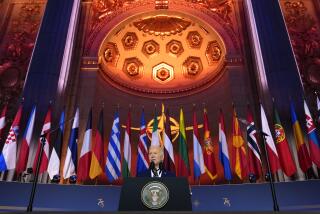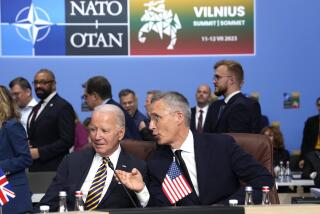NATO Sends Summit Signals : Reassures Soviets, Challenges West
- Share via
Most of what Western leaders said in London last week was meant to reassure Soviet President Mikhail Gorbachev--and perhaps more important, his generals--that his borders are secure. The North Atlantic Treaty Organization, they said, in several different ways, is a defensive body with no “aggressive intentions.” Thus the final NATO summit communique was a political document, nowhere more so than in the final paragraph: “Today, our Alliance begins a major transformation.” But the “major transformation” also carried a message for NATO’s own generals.
Part of the message was that NATO troops no longer will crowd against the border between East and West Germany in a more or less unbroken line ready to block a Soviet attack toward the English Channel. They will give way to a thinner line of troops, mobile enough to move into blocking positions in a crisis. But creating what the communique called more versatile and flexible forces may be the easy part of the transformation. NATO forces now line the border in national units whose troops speak the same language and respond to orders based on the same training in tactics. Now NATO will field multinational units, a move that means intensive retraining so that orders will mean the same thing to all troops.
The NATO communique promised smaller standing forces with an increased reliance on reserves. It proposes eventually to withdraw all nuclear artillery shells from Europe, provided that the Soviet Union does the same.
The communique’s emphasis on smaller and fewer presents a major challenge to the line commanders who must prepare the new units to tackle what is left of NATO’s peacekeeping job now that the threat of a Soviet blitz across Europe has dwindled almost to the vanishing point. But the bigger challenge will be for strategic planners and for political leaders, particularly in the United States.
For the Pentagon, the order to transform NATO adds pressure to produce more realistic assessments of the need for military power over the next couple of decades than it has managed to come up with so far. The NATO communique will make it even harder for military planners to plead for new weapons systems to meet threats that seem ever less likely to materialize.
For political leaders, rummaging through defense spending in search of a peace dividend, the trick will be to avoid budget cuts that will also hurt national security.
Negotiations in Vienna on the numbers of tanks, infantry, tactical aircraft and other conventional forces that NATO and the Warsaw Pact will keep to oversee the winding down of the Cold War seem likely to lead to cuts of perhaps 60% in the strength of Soviet and East European forces. This probably is inevitable. But peace can come to Europe only one step at a time and a conventional forces treaty at Vienna is the obligatory next step.
More to Read
Sign up for Essential California
The most important California stories and recommendations in your inbox every morning.
You may occasionally receive promotional content from the Los Angeles Times.










